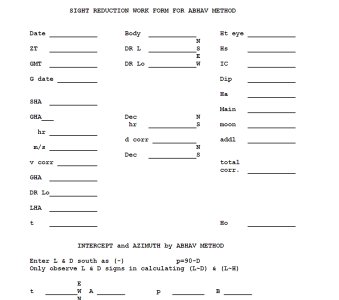
NavList:
A Community Devoted to the Preservation and Practice of Celestial Navigation and Other Methods of Traditional Wayfinding
Re: Abhav sightreduction?
From: Stan K
Date: 2016 Sep 18, 23:03 -0400
From: Stan K
Date: 2016 Sep 18, 23:03 -0400
Axcel,
Attached is the Abhav sight reduction form (Figure 2). Open it with anything but Notepad (Wordpad, Word, etc.). Also attached is a worked example (same opening issues).
Stan
-----Original Message-----
From: Axcel B. <NoReply_AxcelB.@navlist.net>
To: slk1000 <slk1000@aol.com>
Sent: Fri, Sep 16, 2016 3:39 pm
Subject: [NavList] Re: Abhav sightreduction?
From: Axcel B. <NoReply_AxcelB.@navlist.net>
To: slk1000 <slk1000@aol.com>
Sent: Fri, Sep 16, 2016 3:39 pm
Subject: [NavList] Re: Abhav sightreduction?
Hello Dave,
Wow! Thank you for the Excel file. It's quite impressive! Were all these formulas contained in the article? Anyway, now that I have the tables, I was trying to actually do an exercise but got stuck on the next problem now. The instruction below is referring to a work form several times. Unfortunately, I don't have this workform and don't get a correct value anyway. Is there anyone who could help with this please...? Anyone who is familiar with this method? A worked example perhaps? Dave...? Please... :-/
I find this method impressive since it can give you both, Hc and Zn. I hope, we can revive this method...
Thanks
Axcel
Axcel
---------------------------------------------------------------------------------------
USING THE TABLES
Figure 2 shows a sample work form. The top half of the work form is similar to most other work forms and is self explanitory.
- Fill in the data specified to the nearest tenth of a minute of arc and to the nearest second in time.
- Make the necessary computations to end up with values for altitude Ho, declination D and hour angle t.
On the bottom half of the form all angular entries should be to the nearest arcmin.
- Enter t designating it either E or W as appropriate.
- Enter the declination and latitude in the proper spaces. If either is South enter it as a negative number.
- Look up the numbers in the table from the appropriate column for each entry as marked on the form.
- Add the numbers as indicated to equal an A value on the next line.
- Using the tables find a value in the B column which corresponds to the same angle as the A value just computed. When looking up values always use the entry corresponding to the closest input value. It is not necessary to interpolate.
- Determine the L~D which is the absolute value of the difference between L and D taking note of the signs. The only time the negative sign, if any, for L and D is used is when obtaining the difference between two numbers as L~D or L~Hc).
- For this angle get the value from the B column in the table
- Add this B value to the previous B value to get a third B value.
- Now using the table in reverse go in with the B value just determined and get the angle. This angle will be the zenith distance z.
In a similar manner fill in and work out the balance of the sheet.
- Subtract z from 90 to get Hc.
- Enter Ho and take the difference between it and Hc to get the intercept a.
- If Ho is greater than Hc the intercept a will be toward the azimuth direction but if Hc is greater the intercept a will be away from the the azimuth direction.
- Go to the right hand side of the form and enter polar distance in the p space. p is 90 - D. Get the B value from the tables.
- For L~Hc, Observe the sign get the absolute value of the difference between L and Hc. Get the B value from the tables.
- Subtract the second B value from the first B value getting a third B value.
- Using the tables convert this to an A value.
- The L and C entries can be copied from the same values previously used.
- Get a C value from the table for Hc
- Add this to the C value just above it and enter as an s (sum) value.
- Transfer the s value to the s- space where it will be subtracted from the A above it.
- The result will be another A value.
- Enter the table with this A value and come out with an angle which will be the azimuth angle Z.
- convert Z to Zn. The azimuth angle will always have a prefix of N and a suffix to agree with the suffix for t.







